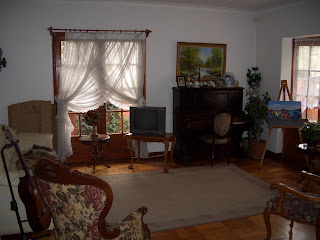Porotos: a stew named after the beans which constitute its thickening and star ingredient, which she claims is a national dish. The namesake does its job; the stew is hearty and heavy, aided by spinach and noodles cooked to a sublime consistency somewhere between "al dente" and "mush." Often accompanying are longanizas, somewhat similar to bratwurst, though a little less rich and a little spicier.
Anticuchos: The kind of kabob you might end up with after tossing a javelin into the deli section at the supermarket. Sparing few beasts of the land, these include different sausages, beef, chicken, prosciutto, and a vegetable or two, strictly for color.
Cauliflower fritters: Exactly what the name implies, these mounds of fried vegetable open a portal to a twilight zone where Cauliflower is not only palatable, but damn near irresistible.
Completos: The Chilean answer to U.S. hot dogs, these wieners obey two fundamental truths, as far as I can tell: always do they come in a toasted bun, and always is the sausage outweighed by the condiments (guacamole, diced tomatoes, mayonnaise).
Cauli-fritters, on right.

These are just the things I remember the names of. Fish, beef, and chicken variously prepared have led many meals, as have delicious soups (Gabriela is fond of the egg-drop inclusion), often accompanied by a salad of some or other composition, be it avocado, tomato, lettuce, beets, or any combination thereof.
But the idiosyncrasies of Chilean cuisine are not confined to the kitchen at 1653 Rep. de Israel. Milk here comes in cardboard-carton liters, and though Gabriela assures me that it is the lesser-fat variety, it tastes more like half & half, and leaves a coating which obscures glass you drink it from. Needless to say, chocolate milk here is reminiscent of liquified cake frosting, and one can down a carton of it with terrifying ease. On a similar wavelength is manjar, referred to elsewhere in South America as dulce de leche. Best explained stateside, it's carmel sauce the viscosity of toothpaste. Comes in foil sacks weighing up to one kilogram (I'll save you the trouble: that's 2.2 pounds of caramel).
In the neighborhood surrounding Universidad Andrés Bello, cheap food abounds, though a far cry from the "fast food" that infects U.S. campuses. Shops hock Cellophane-wrapped sandwiches various in composition: tomato, avocado, mayonnaise is a common and cheap vegetarian staple. Chicken salad with red pepper finely chopped in is another inexpensive and common variety. Popular among the USACers is the chicken cutlet baguette, a particularly long affair adorned with guacamole. The tough, presumably old bread demands devoted and attentive chewing, amplifying the satisfaction of finishing the sandwich (or, conversely, compelling the mastication-weary to save half for later). This accommodatingly priced lunch is especially responsive to aji, a pepper-sauce which has a hefty flavor slightly milder than Tabasco, which can be found in bottles almost everywhere.
In an effort (I can only assume) to produce jobs, the process for purchasing these and many other items around town is as follows: ask man 1 for item, receive paper slip; take slip to man 2, pay, receive stamp on slip; take slip to man 3, exchange for item. Working along with these employees is at least one chef who assembles the more complicated food items. On one occasion, I had to go through no less than five personnel for the meager purchase of a phillips-head screwdriver. It is no doubt a curious and elaborate arrangement to we Norte Americanos, some of us having already grown accustomed to ringing up and paying for our groceries all by our lonesome.
And, of course, there are the empanadas. In varieties limited only by the imagination of the chef, these pasties come fried or baked and sized between a child's fist and a medium-sized purse. The more exotic to make my list have been asparagus and cheese, a delightfully flaky affair I got in the arts-district, and a disappointing seafood version from Pichilemu which exhibited less discerning selection that I would have liked. The standby is piño, stuffed with beef, gravy, olives, hard-boiled eggs, onions, and occasionally, something which may have been an apricot. In a jury-rigged shopping cart parked daily outside class, a woman used to fry cheese empanadas as well as sopapillas (fried dough discs), but she has lately been replaced by a younger man whose product is less satisfying. Word is the lady was arrested, which may be true: new guy can often be seen scanning the streets in all directions with a worried look, presumably watching for carabineros. Regardless of who operates the cart, the salsa is consistently satisfactory, and the sole variable setting the woman and her replacement apart from other vendors in the neighborhood. Dished out with a plastic spoon from a tupperware container, the thin, bright red sauce is an emulsion of tomato and sprigs of cilantro and is just shy of being unbearably salty. My preferred method is to bite a hole in the empanada and ladle the salsa in, turning the pastry to coat the insides.
In other news, the Casablanca trip was postponed. In its stead, I spent another Saturday snowboarding. Having overcome the initial excitement of my ability, I was more aware of my own mortality this time, but I enjoyed myself regardless.

More to come.
































